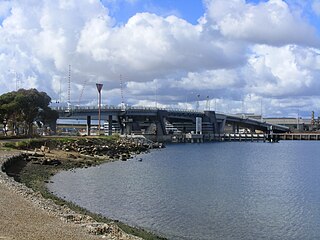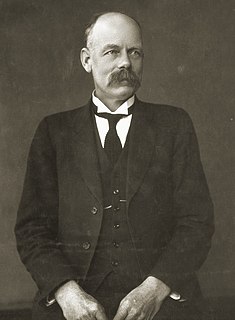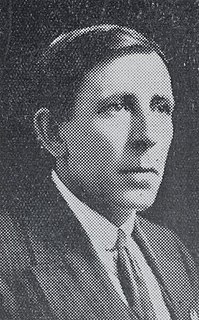
The City of Port Augusta is a local government area located at the northern end of Spencer Gulf in South Australia. It is centred on the town of Port Augusta. The city was the site of South Australia's main power supplier, the Port Augusta powerhouse, located on the coast of the Spencer Gulf.

Birkenhead is a north-western suburb of Adelaide 14 km from the CBD, on the Lefevre Peninsula, in South Australia, and lies within the City of Port Adelaide Enfield. It is adjacent to Peterhead, Exeter and Glanville. It is bounded to the south by the Gawler Reach of the Port River, to the north by Hargrave Street and in the west and east by the Outer Harbor railway line and the Port River respectively.

The Lefevre Peninsula is a peninsula located in the Australian state of South Australia located about 15 kilometres (9.3 mi) northwest of the Adelaide city centre. It is a narrow sand spit of about 30 square kilometres running north from its connection to the mainland.

James Jelley was an Australian politician and trade unionist. He was a Labor member of the South Australian Legislative Council from 1912 to 1933, representing Central District (1912-1915) and Central District No. 1 (1915-1933).

Windsor is a locality in South Australia. It is on the northern Adelaide Plains adjacent to Port Wakefield Road, 34 km southeast of Port Wakefield. The township is largely bypassed by Port Wakefield Road.

Henry "Tick" Phillips was an Australian footballer and champion player for Port Adelaide. He is widely considered to be the club's greatest player of the nineteenth century. Phillips played sixteen seasons for Port Adelaide. For his final two seasons, he was appointed captain.

David Jelley MLC. was a South Australian trades unionist who had a promising career in politics but died in office after one sitting. He was an older brother of James Jelley MLC.
Adelaide Punch (1878–1884) was a short-lived humorous and satirical magazine published in Adelaide, South Australia. Like Melbourne Punch, it was modelled on Punch of London.

John Frederick Drummond (Jack) Jonas was an Australian politician. He represented the South Australian House of Assembly multi-member seat of Port Adelaide from 1927 to 1933 for the Labor Party.
George Feltham Hopkins, informally known as "Hop" or "Geordy", was a politician in colonial South Australia.

The District Council of Lefevre's Peninsula was a local government area in South Australia centred on the Lefevre Peninsula from 1872 to 1884.
The District Council of Glanville was a local government area in South Australia from 1864 to 1888.

The Gawler Football Club was founded on 21 August 1868. In 1877 it was a foundation club of the South Australian Football Association. It had a period of hiatus from the end of 1880 to 1886 when the club split into Athenian and Havelock. The clubs joined together again for the 1887 season along with Albion. However, in the 1890 SAFA season the club finished bottom and decided to leave the Association and form its own league.

The Corporate Town of Semaphore was a local government area in South Australia. It was created on 20 December 1883, and re-gazetted on 17 January 1884, from areas which had been part of the District Council of Lefevre's Peninsula and District Council of Glanville. The separation of Semaphore would make both its former municipalities unviable, with Lefevre's Peninsula subsequently merging into the District Council of Birkenhead and Glanville with the District Council of Woodville. In 1889, the municipality acquired the Semaphore Institute building for use as the Semaphore Town Hall; the building survives today as the heritage-listed Semaphore Library. It amalgamated with the Corporate Town of Port Adelaide on 11 November 1900.
The first Bank of South Australia was founded by the South Australian Company in 1837 and became defunct in 1892.

The District Council of Wirrega was a short-lived local government area in South Australia in existence from 1884 to 1888.

The Hundred of Port Adelaide is a cadastral hundred covering the vicinity of Port Adelaide, Lefevre Peninsula and the coast of the central Adelaide Plains south of Gawler River and west of Port Wakefield Road. It is one of the eleven hundreds of the County of Adelaide and was named in 1846 by Governor Frederick Robe.

The District Council of Yongala was a local government area in South Australia from 1883 to 1935, seated at Yongala.
The Port Adelaide News was a newspaper published in Port Adelaide, South Australia between 1876 and 1933 with various sub-titles, several breaks in publication and several periods of bi-weekly publication.











